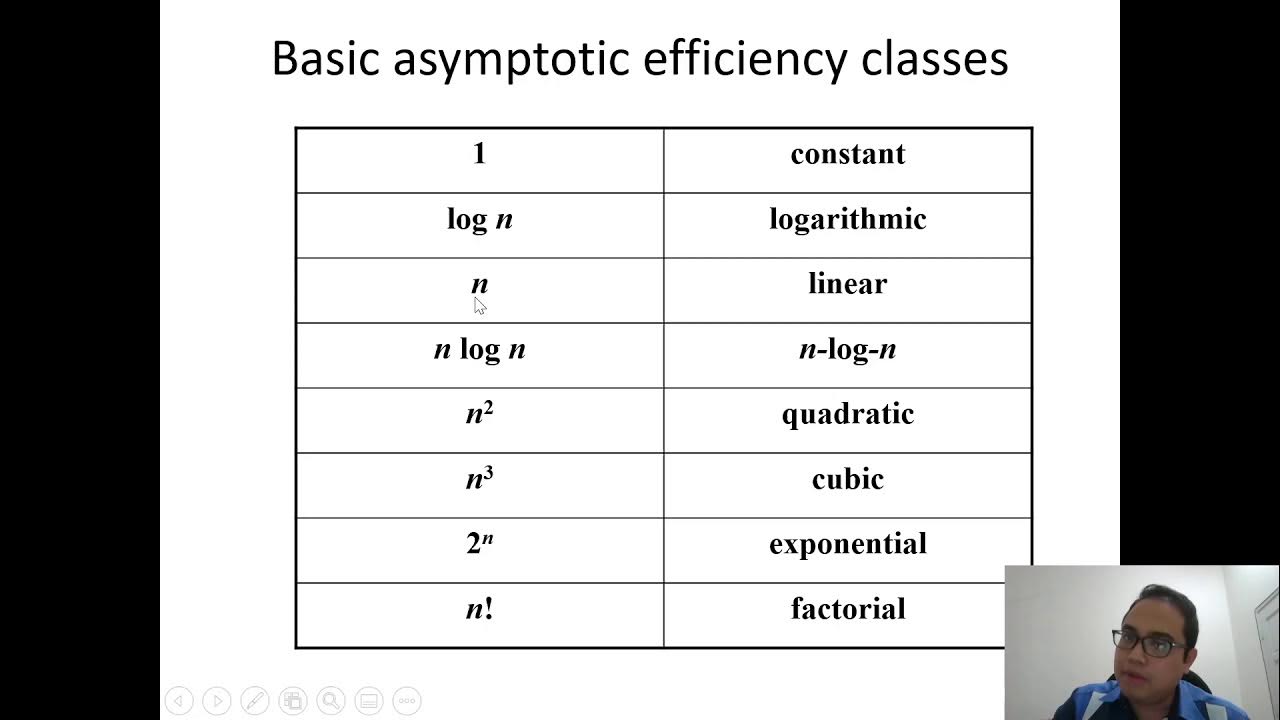TIK-Pencarian dan Pengurutan
Summary
TLDRIn this session, the speaker explains key algorithmic concepts, focusing on searching and sorting techniques. The search process involves finding an object based on criteria within a defined space, while sorting arranges objects according to specific rules. Several sorting algorithms are introduced, including Bubble Sort, Insertion Sort, and Selection Sort, with comparisons made between them. The speaker highlights the efficiency and logic behind each method, discussing how each algorithm works through step-by-step examples. The session concludes by touching on other sorting techniques, such as Merge Sort, and hints at future lessons on queues and stacks.
Takeaways
- 😀 Searching is a process of finding something based on specific criteria in a search space, like searching for a math book on a bookshelf.
- 😀 Sorting refers to arranging a group of objects or entities in a specific order, following certain rules, which can be computationally intensive.
- 😀 There are three key elements in a search: the object (e.g., a book), the criteria (e.g., mathematics), and the scope or space in which to search (e.g., a bookshelf).
- 😀 Sequential or linear search involves checking each element in a list one by one until the target is found. This can take several steps, even for small datasets.
- 😀 A sorting algorithm works to arrange data in a specified order, and it can involve several methods, including Bubble Sort, Insertion Sort, and Selection Sort.
- 😀 Bubble Sort is a simple but inefficient algorithm, where elements are compared and swapped, with the smallest 'bubbling' to the top. However, it involves many steps and is slower for larger datasets.
- 😀 Insertion Sort compares two adjacent numbers, inserting them into their correct position relative to each other. It’s more efficient than Bubble Sort for smaller datasets.
- 😀 Selection Sort uses three tables: one for sorted data, one for unsorted data, and one for selected data. It repeatedly selects the smallest element from the unsorted table and moves it to the sorted table.
- 😀 Comparing Bubble Sort, Insertion Sort, and Selection Sort: Bubble Sort compares all data points, Insertion Sort compares adjacent ones, and Selection Sort uses a helper table to more effectively sort data.
- 😀 The effectiveness of a sorting algorithm depends on the size of the data. For small datasets, simpler algorithms may work fine, but for larger datasets, more efficient methods are needed.
Q & A
What are the two main types of algorithms discussed in the script?
-The two main types of algorithms discussed are searching algorithms and sorting algorithms.
What are the three main components involved in any search algorithm?
-The three main components involved in a search algorithm are the object being searched for, the criteria that define the object, and the search space where the object is located.
How does a sequential (linear) search algorithm work?
-In a sequential search, the algorithm checks each element one by one in a list until it finds the target element. The process continues until a match is found or all elements are checked.
How does the human brain differ from a computer in processing a search?
-Humans can quickly identify the target without consciously thinking through each step, while computers process each step in detail, checking every element to ensure accuracy, which can be slower.
What is Bubble Sort and how does it work?
-Bubble Sort is a sorting algorithm that compares adjacent elements and swaps them if they are in the wrong order. The algorithm continues this process until all elements are sorted. It is simple but inefficient for large datasets.
What is the main disadvantage of Bubble Sort?
-The main disadvantage of Bubble Sort is that it requires many comparisons and swaps, making it inefficient for large datasets.
What is Insertion Sort and how is it different from Bubble Sort?
-Insertion Sort works by taking each element and inserting it into its correct position relative to the already sorted portion of the list. Unlike Bubble Sort, which compares adjacent elements repeatedly, Insertion Sort builds the sorted list gradually by comparing each element with already sorted ones.
How does Selection Sort differ from Insertion Sort?
-Selection Sort selects the smallest element from the unsorted portion of the list and places it in the sorted portion, while Insertion Sort picks elements one by one and inserts them into their correct positions in the sorted list.
What is the key advantage of Selection Sort over Bubble Sort?
-Selection Sort is more efficient than Bubble Sort because it requires fewer swaps, even though both algorithms have similar time complexities.
Why are the steps involved in sorting algorithms more apparent in computers than in humans?
-Computers process each step methodically and compare every element, making the sorting process more visible and slower compared to humans who use their experience to quickly recognize patterns and make decisions without going through every step.
Outlines

هذا القسم متوفر فقط للمشتركين. يرجى الترقية للوصول إلى هذه الميزة.
قم بالترقية الآنMindmap

هذا القسم متوفر فقط للمشتركين. يرجى الترقية للوصول إلى هذه الميزة.
قم بالترقية الآنKeywords

هذا القسم متوفر فقط للمشتركين. يرجى الترقية للوصول إلى هذه الميزة.
قم بالترقية الآنHighlights

هذا القسم متوفر فقط للمشتركين. يرجى الترقية للوصول إلى هذه الميزة.
قم بالترقية الآنTranscripts

هذا القسم متوفر فقط للمشتركين. يرجى الترقية للوصول إلى هذه الميزة.
قم بالترقية الآنتصفح المزيد من مقاطع الفيديو ذات الصلة

Learn Searching and Sorting Algorithm in Data Structure With Sample Interview Question

EDB1 IMD UFRN (2020.6): Problema de Ordenação

DESKRIPSI SIFAT FISIK BAHAN PANGAN 2

EDB1 IMD UFRN : Introdução a TAD Conjunto e Sequência

Kadane's Algorithm | Maximum Subarray Sum | DSA Series by Shradha Ma'am

CSC645 - Chapter 1 (Continued) - Fundamentals of Algorithm Analysis
5.0 / 5 (0 votes)
